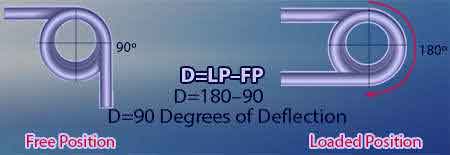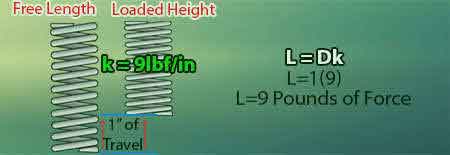Deflection of Compression, Extension and Torsion Springs
Definition
Spring deflection, also known as spring travel, is the action of a compression spring compressing (being pushed), an extension spring extending (being pulled), or a torsion spring torquing (radially) when a load is applied or released.
In order for deflection to take place on a compression, extension or torsion spring, a load must be either applied or removed. The distance between the loaded length or position and the free or pre-loaded position is known as distance of travel. A traveled distance is exactly what deflection is. Whether it is pushed, pulled, or torqued. Spring deflection is deeply related to your spring’s rate.
Example 1.)
Spring rate is the amount of force it’ll take your spring to deflect a certain amount of distance traveled. To calculate the amount of deflection you may achieve under a certain load, you may calculate it by dividing the required load by the spring rate. If this is an extension spring, you must subtract the initial tension from the load first. In case that you are only aware of your spring’s required loaded state, subtract the loaded height or position from the free position or length of your spring.
Calculate Deflection Using Spring Rate:
Deflection=Load÷Rate
D=L÷k
Deflection=(Load–Initial Tension)÷Rate
D=(L–IT)÷k
Calculate Deflection Using Loaded Position:
Deflection=Loaded Position–Free Position
D=LP–FP
Example Diagrams


Example 2.)
The diagrams provided to the right tell you exactly how the formulas provided work. You may also read other technical articles under the “Tech Info” tab on our menu. There are multiple articles talking about compression spring design as well as extension spring design and torsion spring design. The calculator will automatically calculate the spring rate along with maximum safe travel or deflection and maximum safe load. If you follow the rate formula and example below, you will notice that these values (maximum safe load and travel) are each the product of each other.
Calculate Deflection and Load from Each Other:
Deflection = Load ÷ Rate
D=L÷k
Load = Deflection * Rate
L=Dk
Calculate Deflection Using Loaded Length





 Español
Español